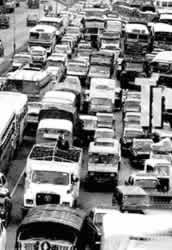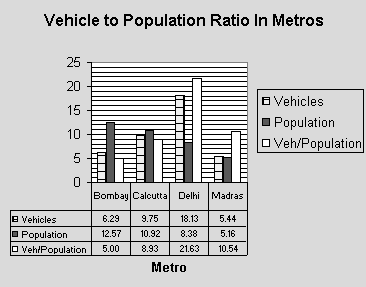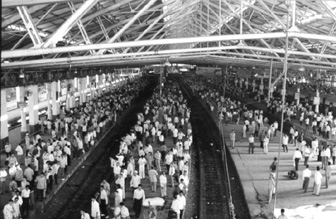Main Page
History Development
Efforts by Railway Other
Projects by IIT Bombay On Local Trains Redesign
Project Current
Status Other
Railway Site. Indian Urban Transportation
Bombay Urban Transport
Bombay Urban Rail Scenario
.....6 million people commute daily on this network
....average peak hour load being 4500 – 5000 commuters per train
...commuter density inside the trains reach 9-14 persons/meter square
Urban Transportation in India.
 The problem of urban transport in the
developing countries in further augmented by the high volumes, different speeds
of various modes and the comfort level (read discomfort).The rail and road infrastructures
are just not able to cater to the exponential growth of the population. This leads
to congested and longer journeys on the road and in the trains. The severe nature
of the problem is evident in the Calcutta Trams, Delhi buses and to top it all
The Bombay Local trains. The design of infrastructures dates long back and did
not have any provisions for the explosive growth in the commuter traffic in the
future. The role of the Urban transport is of high importance in or metropolises.
The town plans and the economics of our metropolises demand extensive travels
from the residential areas (driven to periphery) to the business districts in
the center of the town.
The problem of urban transport in the
developing countries in further augmented by the high volumes, different speeds
of various modes and the comfort level (read discomfort).The rail and road infrastructures
are just not able to cater to the exponential growth of the population. This leads
to congested and longer journeys on the road and in the trains. The severe nature
of the problem is evident in the Calcutta Trams, Delhi buses and to top it all
The Bombay Local trains. The design of infrastructures dates long back and did
not have any provisions for the explosive growth in the commuter traffic in the
future. The role of the Urban transport is of high importance in or metropolises.
The town plans and the economics of our metropolises demand extensive travels
from the residential areas (driven to periphery) to the business districts in
the center of the town.
Urban Transport Scenario in Bombay.
 The
problem in Bombay is unique in nature. The percentage of people in Bombay utilizing
the services of Public Transport in Bombay is the highest amongst all the Metropolises
(see the accompanying table). This figure is not only high in terms of fraction
but also in shear numbers. The extensive commercialization, and thus the high
land value, in the Southern Bombay demands extensive travel from suburbs (even
as far as Talegaon & Poona) on a daily basis. This large volume of commuters
is catered, in order, by Rail, Buses (BEST & privately owned) and Water transport.
All these modes are interdependent and supplementary to each other. Amongst the
three modes the later two have shown considerable changes with the time and growing
needs. BEST came up with change in fixtures, luxury and Air conditioned buses,
ticket validating machines, hydraulic doors, etc. Water transport showed introduction
of Hovercraft and Speed Boats along with the normal ferries. Only changes introduced
in the Railways were in terms of reducing the number of seats, materials and exteriors,
introduction of 12 coach rakes. The Urban Rail transport is unable to cope up
with the extreme demands of the Urban Transportation in terms of quality and service.
The data source is "Urban Transport in India" (see bibliography). The vehicles
are numbered in lakhs and population is in millions, the ratio is multiplied by
10 for compatibility on a single graph
The
problem in Bombay is unique in nature. The percentage of people in Bombay utilizing
the services of Public Transport in Bombay is the highest amongst all the Metropolises
(see the accompanying table). This figure is not only high in terms of fraction
but also in shear numbers. The extensive commercialization, and thus the high
land value, in the Southern Bombay demands extensive travel from suburbs (even
as far as Talegaon & Poona) on a daily basis. This large volume of commuters
is catered, in order, by Rail, Buses (BEST & privately owned) and Water transport.
All these modes are interdependent and supplementary to each other. Amongst the
three modes the later two have shown considerable changes with the time and growing
needs. BEST came up with change in fixtures, luxury and Air conditioned buses,
ticket validating machines, hydraulic doors, etc. Water transport showed introduction
of Hovercraft and Speed Boats along with the normal ferries. Only changes introduced
in the Railways were in terms of reducing the number of seats, materials and exteriors,
introduction of 12 coach rakes. The Urban Rail transport is unable to cope up
with the extreme demands of the Urban Transportation in terms of quality and service.
The data source is "Urban Transport in India" (see bibliography). The vehicles
are numbered in lakhs and population is in millions, the ratio is multiplied by
10 for compatibility on a single graph
Urban Rail Transport in Bombay.
 The
trains grew and developed with city. It is virtually the life line of the city
and thus holds great importance in its development. Dividing the city into east
and west the suburban rail network covers taking an average rail trip of 24 km.
This average trip is four times the average bus route. As per the data provided
by the railway authorities, the nine coach rakes bring in as much as 4500 - 5000
people per trip during the peak hours. The figure of 5000 provides us with the
grim picture of the conditions of the local train coaches. As per the engineers
of the ‘Railway workshop’, the coaches are specially reinforced to take up these
additional loads. During peak hours 96 train come into CST and 104 leave in the
evening.
The
trains grew and developed with city. It is virtually the life line of the city
and thus holds great importance in its development. Dividing the city into east
and west the suburban rail network covers taking an average rail trip of 24 km.
This average trip is four times the average bus route. As per the data provided
by the railway authorities, the nine coach rakes bring in as much as 4500 - 5000
people per trip during the peak hours. The figure of 5000 provides us with the
grim picture of the conditions of the local train coaches. As per the engineers
of the ‘Railway workshop’, the coaches are specially reinforced to take up these
additional loads. During peak hours 96 train come into CST and 104 leave in the
evening.
Mumbai is one of the excellent examples of the well-located suburban train lines
that forms the backbone of the commuter traffic within the city. The railway network
operation is through two terminuses namely CST (Chhatrapati Shivaji Terminus,
earlier known as Victoria Terminus) and Churchgate. According to the 1993 data
almost 49.5 lakhs people commute by these rails daily making it the busiest commuter
railway in the South Asia. Churchgate is the terminus for the Western railway
and CST is for Central railway. The harbour line connects the Western and the
Central Lines (As future railway projects an underground or elevated rail is being
planned). The central line has 102 rakes in service. Eighty-four rakes are running
and 4 are standby and remaining are under overhauling. The service utilization
is at its fullest extent throughout the day. During the peak hours the frequency
of the trains is 4-7 minutes depending upon the type of the track. The gravity
and criticality of the problem are most evident during the peak hours.

Chhatrapati Shivaji Terminus, at peak hour, showing the commuters waiting for
the train. This picture repeats every 5 minutes during peak hours. 
The existing and the proposed suburban network of the Bombay Suburban network
showing its vastness. It also gives an idea of the load carried by the network
in the city.
Main Page
History Development
Efforts by Railway Other
Projects by IIT Bombay On Local Trains Redesign
Project Current
Status Other
Railway Site.


 The problem of urban transport in the
developing countries in further augmented by the high volumes, different speeds
of various modes and the comfort level (read discomfort).The rail and road infrastructures
are just not able to cater to the exponential growth of the population. This leads
to congested and longer journeys on the road and in the trains. The severe nature
of the problem is evident in the Calcutta Trams, Delhi buses and to top it all
The Bombay Local trains. The design of infrastructures dates long back and did
not have any provisions for the explosive growth in the commuter traffic in the
future. The role of the Urban transport is of high importance in or metropolises.
The town plans and the economics of our metropolises demand extensive travels
from the residential areas (driven to periphery) to the business districts in
the center of the town.
The problem of urban transport in the
developing countries in further augmented by the high volumes, different speeds
of various modes and the comfort level (read discomfort).The rail and road infrastructures
are just not able to cater to the exponential growth of the population. This leads
to congested and longer journeys on the road and in the trains. The severe nature
of the problem is evident in the Calcutta Trams, Delhi buses and to top it all
The Bombay Local trains. The design of infrastructures dates long back and did
not have any provisions for the explosive growth in the commuter traffic in the
future. The role of the Urban transport is of high importance in or metropolises.
The town plans and the economics of our metropolises demand extensive travels
from the residential areas (driven to periphery) to the business districts in
the center of the town.  The
problem in Bombay is unique in nature. The percentage of people in Bombay utilizing
the services of Public Transport in Bombay is the highest amongst all the Metropolises
(see the accompanying table). This figure is not only high in terms of fraction
but also in shear numbers. The extensive commercialization, and thus the high
land value, in the Southern Bombay demands extensive travel from suburbs (even
as far as Talegaon & Poona) on a daily basis. This large volume of commuters
is catered, in order, by Rail, Buses (BEST & privately owned) and Water transport.
All these modes are interdependent and supplementary to each other. Amongst the
three modes the later two have shown considerable changes with the time and growing
needs. BEST came up with change in fixtures, luxury and Air conditioned buses,
ticket validating machines, hydraulic doors, etc. Water transport showed introduction
of Hovercraft and Speed Boats along with the normal ferries. Only changes introduced
in the Railways were in terms of reducing the number of seats, materials and exteriors,
introduction of 12 coach rakes. The Urban Rail transport is unable to cope up
with the extreme demands of the Urban Transportation in terms of quality and service.
The data source is "Urban Transport in India" (see bibliography). The vehicles
are numbered in lakhs and population is in millions, the ratio is multiplied by
10 for compatibility on a single graph
The
problem in Bombay is unique in nature. The percentage of people in Bombay utilizing
the services of Public Transport in Bombay is the highest amongst all the Metropolises
(see the accompanying table). This figure is not only high in terms of fraction
but also in shear numbers. The extensive commercialization, and thus the high
land value, in the Southern Bombay demands extensive travel from suburbs (even
as far as Talegaon & Poona) on a daily basis. This large volume of commuters
is catered, in order, by Rail, Buses (BEST & privately owned) and Water transport.
All these modes are interdependent and supplementary to each other. Amongst the
three modes the later two have shown considerable changes with the time and growing
needs. BEST came up with change in fixtures, luxury and Air conditioned buses,
ticket validating machines, hydraulic doors, etc. Water transport showed introduction
of Hovercraft and Speed Boats along with the normal ferries. Only changes introduced
in the Railways were in terms of reducing the number of seats, materials and exteriors,
introduction of 12 coach rakes. The Urban Rail transport is unable to cope up
with the extreme demands of the Urban Transportation in terms of quality and service.
The data source is "Urban Transport in India" (see bibliography). The vehicles
are numbered in lakhs and population is in millions, the ratio is multiplied by
10 for compatibility on a single graph
 The
trains grew and developed with city. It is virtually the life line of the city
and thus holds great importance in its development. Dividing the city into east
and west the suburban rail network covers taking an average rail trip of 24 km.
This average trip is four times the average bus route. As per the data provided
by the railway authorities, the nine coach rakes bring in as much as 4500 - 5000
people per trip during the peak hours. The figure of 5000 provides us with the
grim picture of the conditions of the local train coaches. As per the engineers
of the ‘Railway workshop’, the coaches are specially reinforced to take up these
additional loads. During peak hours 96 train come into CST and 104 leave in the
evening.
The
trains grew and developed with city. It is virtually the life line of the city
and thus holds great importance in its development. Dividing the city into east
and west the suburban rail network covers taking an average rail trip of 24 km.
This average trip is four times the average bus route. As per the data provided
by the railway authorities, the nine coach rakes bring in as much as 4500 - 5000
people per trip during the peak hours. The figure of 5000 provides us with the
grim picture of the conditions of the local train coaches. As per the engineers
of the ‘Railway workshop’, the coaches are specially reinforced to take up these
additional loads. During peak hours 96 train come into CST and 104 leave in the
evening. 
